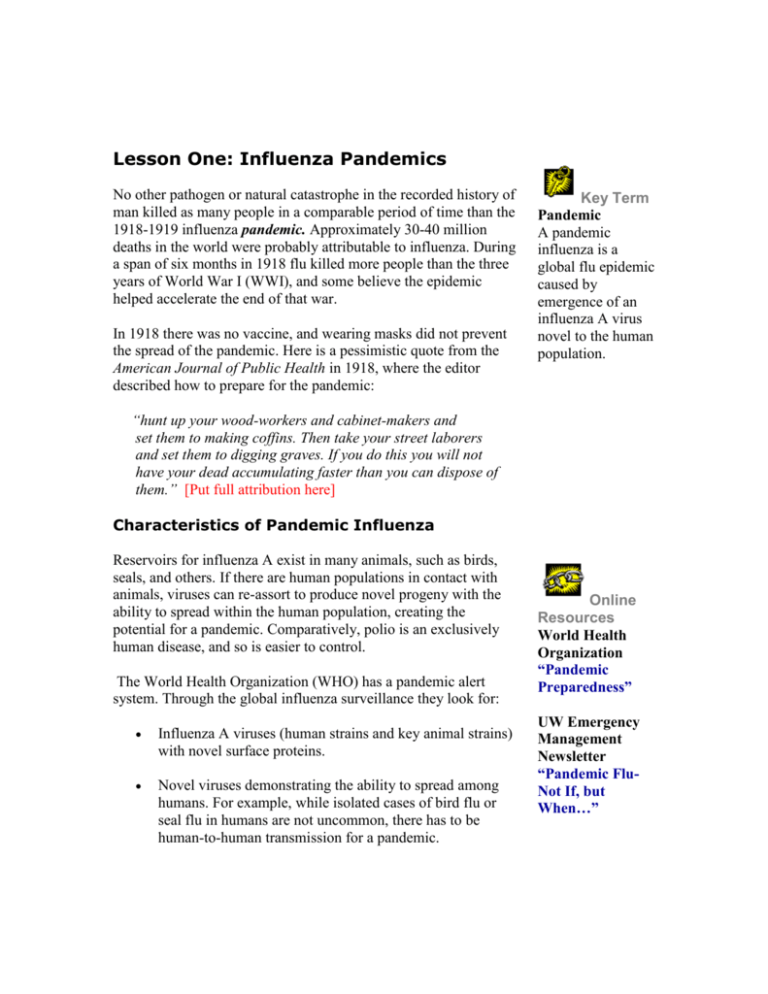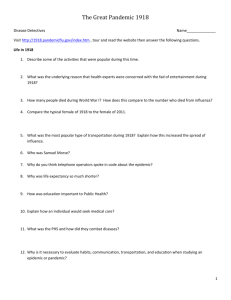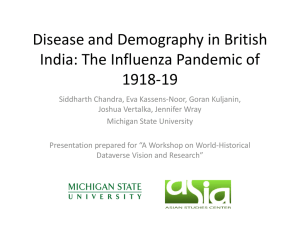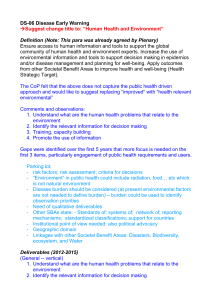Historical Perspective
advertisement

Lesson One: Influenza Pandemics No other pathogen or natural catastrophe in the recorded history of man killed as many people in a comparable period of time than the 1918-1919 influenza pandemic. Approximately 30-40 million deaths in the world were probably attributable to influenza. During a span of six months in 1918 flu killed more people than the three years of World War I (WWI), and some believe the epidemic helped accelerate the end of that war. In 1918 there was no vaccine, and wearing masks did not prevent the spread of the pandemic. Here is a pessimistic quote from the American Journal of Public Health in 1918, where the editor described how to prepare for the pandemic: Key Term Pandemic A pandemic influenza is a global flu epidemic caused by emergence of an influenza A virus novel to the human population. “hunt up your wood-workers and cabinet-makers and set them to making coffins. Then take your street laborers and set them to digging graves. If you do this you will not have your dead accumulating faster than you can dispose of them.” [Put full attribution here] Characteristics of Pandemic Influenza Reservoirs for influenza A exist in many animals, such as birds, seals, and others. If there are human populations in contact with animals, viruses can re-assort to produce novel progeny with the ability to spread within the human population, creating the potential for a pandemic. Comparatively, polio is an exclusively human disease, and so is easier to control. The World Health Organization (WHO) has a pandemic alert system. Through the global influenza surveillance they look for: Influenza A viruses (human strains and key animal strains) with novel surface proteins. Novel viruses demonstrating the ability to spread among humans. For example, while isolated cases of bird flu or seal flu in humans are not uncommon, there has to be human-to-human transmission for a pandemic. Online Resources World Health Organization “Pandemic Preparedness” UW Emergency Management Newsletter “Pandemic FluNot If, but When…” Substantial proportion of the population with little or no antibodies to the novel virus. Historical Perspective Descriptions of influenza disease existed for centuries before scientists isolated the influenza virus in the 1930s. The hallmark of epidemic influenza is excess mortality, making it a great disease to study epidemiologically. The study of influenza started in 1837 with Robert Gray, a physician in Dublin, Ireland, who noticed an association between excess mortality and the winter season. Winter brought a rise in acute onsets of febrile respiratory disease, and more people died. Gray went to cemeteries in the spring and counted the number of tombstones. He was the first to associate more deaths with winter season epidemics of febrile respiratory disease. Selwyn Collins mapped influenza epidemiology systematically over a 50-year period in the U.S. Collins noticed that, with some fluctuations, the baseline death level was higher in winter than in summer. He recognized clinically and epidemiologically that more people were sick and more children missed school in winter. Collins also noticed an association with excess mortality when there were flu epidemics of four to six weeks. The 1918 influenza virus was isolated from two sources of preserved human tissue. During WW I, a number of soldiers died of a rapid hemorrhagic pneumonia, so the Armed Forces Institute of Pathology preserved some human tissue. In addition, the pandemic decimated Alaskan natives. Mortality rate was 70% in some villages because influenza was new to the natives. Natives buried the bodies in mass graves, where the permafrost preserved the virus. Researchers from the Armed Forces Institute of Pathology used viral RNA techniques to isolate H1N1 influenza virus type A from the Alaskan site. Using both epidemiologic and molecular biology methods, these researchers showed that both the WWI soldiers and the Alaskan natives had the same strain of influenza. Twentieth Century Pandemics It is interesting to look at the great pandemics of the last 100 years, including the 1892 pandemic in Massachusetts, the 1918 pandemic, and the pandemics of 1936 and 1957. Figure 1.0 plots Key Term Excess Mortality William Farr studied flu deaths in London scientifically and coined the phrase to refer to additional mortality due to influenza, rather than compensatory mortality, the early deaths of sick or old people who were dying anyway. the death rates of these four pandemics. Figure 1.0—Death Rates from Influenza Plotted by Age at Death Plotting deaths during influenza epidemics usually creates a Ushaped curve, with the highest mortality in the elderly and the very young. An interesting feature of the 1918 curve is the W-shaped curve and the high death rate in young people. There are explanatory hypotheses about many young men gathering in close quarters during the war, but women actually had mortality rates as high (pregnant women had mortality rates up to 50%), and there is no good explanation for this unusual curve. Mortality rates decreased over time due to improved treatment of secondary diseases resulting from a better understanding of the disease pathogenesis. Influenza worsens underlying diseases and can lead to bacterial pneumonia, but many of these diseases are now treatable with antibiotics and supportive care. In the U.S. today, there are still 10-40,000 deaths a year from flu and 90% of them occur in people over the age of 70. So the total fatal cases and the rates are lower, but the age pattern of the fatal cases remains; the highest mortality occurs in older people. Prevention To prevent a potential pandemic, you need Global surveillance centers--even 10 years ago we had surveillance in the U.S., but not in Asia, where many influenza strains originate. Labs--to map the genes to see if the virus is an influenza A virus with a novel surface protein. Strong communication and vigilance--WHO has an email influenza alert system. Intervention— in addition to isolation and containment, as was done for SARS. Rapid vaccine production or distribution of influenza antiviral medications--with a novel antigen, it takes about six months every year for vaccine development (via embryonated hens’ eggs) after surveillance designates which strains are likely to circulate. It takes some time to distribute the vaccine. In a pandemic situation there may not be enough time to develop and deliver a vaccine before the virus circulates the globe. Thus we need rigorous surveillance, rapid communication, emergency preparedness (with an isolation and quarantine plan), and a plan for intervention with vaccinations or antiviral medication. Summary Influenza pandemics hold the potential to kill millions of people all over the world. As humans come into increasing contact with animals, animal viruses re-sort genetically to produce strains new to humans that can be passed from person to person. These pandemics cause excess mortality, killing those who would not normally die. Studies of recent pandemics indicate that children and older people are particularly at risk. Improved treatments lessen the risk, but there are still thousands of deaths in the U.S. each year. Preventing influenza pandemics requires surveillance, communication, emergency preparedness, and a plan for vaccinations or antiviral medications. Self-Study Questions Answer these questions to review the material and test your knowledge.





